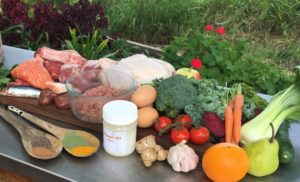
While completing my certificate in pet food nutrition for my new book Eat, Play, Love Your Dog, I became aware of how high levels of carbohydrates in dog food can impact on your dog’s health.
While we might look out for extra sugar listed in our own food and try to avoid it, many people may not think about the amount of carbohydrates are actually in their dog’s diet and how these then covert into sugar.
Many owners also probably don’t realise that in many commercial dog foods, kibble in particular, carbohydrates now form a major part of a typical pet’s diet when they are feed kibble.
Technically dogs don’t have any requirement for carbohydrates in the same way that they need protein and fats to survive.
This is why we likely see such low levels of carbohydrates in the evolutionary diet where, in the wild, a dog would have consumed only around 5% carbohydrates in their diet from fruits and vegetables or from that found in the stomach of their prey.
In an average dry commercial kibble packet, there can be between 30-60% carbohydrate content, so it is it is important for people to understand is that there are huge differences in the types of carbohydrates in dog food, which can influence sugar levels.
It is important to point out that because of the extrusion process require to make dry dog food, a minimum of about 30% starch is required to make the dry kibble, so it is totally unavoidable.
When all of the ingredients are mixed together to form a dough, they are then pushed through a production process under intense heat and pressure before being cut into the shapes we see in the dry food packets, so the starch is required to bind all of these ingredients together.
It is rather complex, but not all carbs are the same. So, when looking at the carbohydrates in dog food it is important to understand the different types and what this means in terms of sugar.
Fibre is a complex carbohydrate which is the non-digestible part of plant, while the other part is starch which in simple turns breaks down into sugar.
Starch is the main type of carbohydrate found in commercial dry foods and mainly comes from cereal grains such as wheat, barley, corn, rice and soy, which are used by a lot of kibble companies. However, studies have shown that grains can have an inflammatory effect in our dogs.
Starch is also found in root vegetables such as potato, sweet potato and cassava, as well as in legumes such as lentils, beans and dried peas. So just because a kibble claims to be ‘grain-free’, it certainly does not mean that it doesn’t contain carbohydrates (or sugar).
Non-starchy carbohydrates are foods like our fresh fruits and above-ground vegetables, which are great sources of phytonutrients and fibre that support the health of our dogs.
You tend to see non-starchy carbohydrates added to raw food diets such as Big Dog Pet Foods because of the benefits they provide to digestive and immune health and overall well-being.
We are certainly seeing a significant increase in obesity in dogs and diseases that occur as a result of obesity, such as diabetes and heart disease, with high levels of sugar in our dog’s diets being one of the causes, as well as over feeding and a lack of sufficient exercise.
Excess sugar in your dog’s diet may also contribute to increased cancer risk, allergies, and yeast infections.
So, if your dog is constantly struggling with ear infections or skin conditions, or is on a dry dog food diet only, it is worth taking a look at how much sugar is actually in your dogs’ diet and assess what you are feeding them.
A quick and easy way to estimate the amount of carbohydrates in any dog food is looking at the Guaranteed Analysis table on the pet food label.
Dog foods are not required to list the amount of carbohydrates in the food as it is not required as part of the dog’s diet. However, basically all dog foods do contain the same four major nutrients — known as macronutrients being:
In addition, all foods also contain ash, which is the mineral residue left if you burnt away all the protein, fat and carbs.
Ash content can vary but usually the benchmark of 8% ash is used when trying to work out different amounts in the Guaranteed Analysis.
Given carbohydrates in dog food are not listed, you can work out this missing figure by adding together the percentages of those that are listed (plus Ash) ie: Protein + Fat + Ash + Water.
Then minus this total amount from the total 100% and the remaining number is the estimated percentage of carbohydrate in the food.
If fiber is listed as a percentage, you don’t include that when adding together the other ingredients, as it is a type of carbohydrate so will be automatically included in your carbohydrate calculation.
As high levels of carbohydrates in dog food are unavoidable if you feed your dog kibble, you can still reduce the amount of these hidden sugars in your dog’s food by introducing a complete and balanced raw food into your dog’s diet, such as Big Dog.
You will need to know your dog’s ideal daily calorie intake and reduce the amount of dry dog food accordingly to avoid over feeding, as well as transitioning any raw food into your dog’s diet slowly.
Click here for details on how to transition your dog across to a new diet to avoid stomach upsets.
About the Author: Lara Shannon is a certified dog behaviourist and trainer, pet food nutrition specialist, Executive Producer and Host of Pooches at Play on Channel 10 and editor of Poochesatplay.com. Lara also runs her own dog training business in Melbourne’s Bayside area and is the Author of World of Dogs and Eat, Play, Love Your Dog

Tips for preparing a raw food diet for your pet


Winter safety for dogs – Top Tips


Bladder Stones in Dogs and Cats


Get your paws on Lara Shannon’s best selling books ‘Eat, Play, Love (your dog) and World of Dogs.
Available in Australia, USA, UK and Canada.